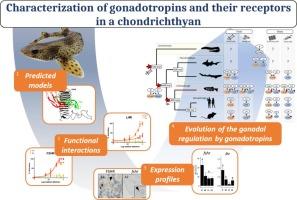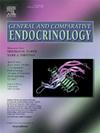Characterization of gonadotropins and their receptors in a chondrichthyan, Scyliorhinus canicula, fills a gap in the understanding of their coevolution
IF 1.7
3区 医学
Q3 ENDOCRINOLOGY & METABOLISM
引用次数: 0
Abstract
In Gnathostomes, reproduction is mainly controlled by the hypothalamic-pituitary–gonadal (HPG) axis, with the involvement of the pituitary gonadotropic hormones (GTH), follicle-stimulating hormone (FSH) and luteinizing hormone (LH), which activate their cognate receptors, FSHR and LHR, expressed in gonads. Each GTH consists of a common α subunit and of a specific FSHβ or LHβ subunit. Chondrichthyes (holocephalans and elasmobranchs) is a sister group of bony vertebrates. This position is highly favorable for the understanding of the evolution of endocrine regulations of reproduction among gnathostomes. Surprisingly, the characterization of gonadotropins and their receptors is still limited in chondrichthyes. In the present study, GTH and GTHR sequences have been identified from several chondrichthyan genomes, and their primary structures were analyzed relative to human orthologs. 3D models of GTH/GTHR interaction were built, highlighting the importance of the receptor hinge region for ligand recognition. Functional hormone-receptor interactions have been studied in HEK cells using the small-spotted catshark (Scyliorhinus canicula) recombinant proteins and showed that LHR was specifically activated by LH whereas FSHR was activated by both FSH and LH. Expression profiles of GTHs and their receptors were explored by real-time PCR, in situ hybridization and immunohistochemistry during spermatogenesis, along the male genital tract and other tissues, as well as in some female tissues for comparison. Tissue-expression analyses showed that the highest levels were observed for fshr transcripts in testis and ovary and for lhr in specific extragonadal tissues. The two receptors were expressed at all stages of spermatogenesis by both germ cells and somatic cells, including undifferentiated spermatogonia, spermatocytes, spermatids, somatic precursors and Sertoli cells; differentiated Leydig cells being absent in the testis of S. canicula. Receptors were also expressed by the lymphomyeloid epigonal tissue and the testicular tubules. These results, suggest a wide range of gonadotropin-regulated functions in Elasmobranchs, as well as functional redundancy during spermatogenesis. These extended functions are discussed in an evolutionary context in which the specificity of gonadotropin signaling must have contributed to the evolution of gonadal cells’ morphology and function.

对一种软骨鱼类--可口棘尾鱼--的促性腺激素及其受体的特征描述,填补了对它们共同进化的认识空白
在性腺线虫中,生殖主要由下丘脑-垂体-性腺轴(HPG)控制,垂体促性腺激素(GTH)、卵泡刺激素(FSH)和黄体生成素(LH)参与其中,它们激活在性腺中表达的同源受体 FSHR 和 LHR。每种 GTH 都由一个共同的 α 亚基和一个特定的 FSHβ 或 LHβ 亚基组成。软骨鱼类(全头目和箭鳃目)是有骨脊椎动物的姊妹类群。这一地位非常有利于了解地龙类生殖内分泌调控的进化。令人惊讶的是,软骨鱼类中促性腺激素及其受体的特征描述仍然有限。本研究从多个软骨鱼类基因组中鉴定了GTH和GTHR序列,并分析了它们与人类同源物的主要结构。建立了 GTH/GTHR 相互作用的三维模型,突出了受体铰链区对配体识别的重要性。利用小斑猫鲨(Scyliorhinus canicula)重组蛋白在HEK细胞中研究了功能性激素-受体相互作用,结果显示LHR被LH特异性激活,而FSHR则被FSH和LH同时激活。通过实时聚合酶链反应、原位杂交和免疫组织化学方法,研究了精子发生过程中、男性生殖道和其他组织以及一些女性组织中 GTHs 及其受体的表达谱。组织表达分析表明,睾丸和卵巢中的fshr转录物水平最高,而绒毛外特定组织中的lhr转录物水平最高。在精子发生的各个阶段,生殖细胞和体细胞都表达这两种受体,包括未分化的精原细胞、精母细胞、精子细胞、体细胞前体细胞和 Sertoli 细胞;在 S. canicula 的睾丸中没有分化的 Leydig 细胞。淋巴细胞上皮组织和睾丸小管也表达受体。这些结果表明,促性腺激素在鳞鳃亚纲动物中具有广泛的调节功能,并且在精子发生过程中存在功能冗余。这些扩展的功能将在进化的背景下进行讨论,其中促性腺激素信号的特异性一定促进了性腺细胞形态和功能的进化。
本文章由计算机程序翻译,如有差异,请以英文原文为准。
求助全文
约1分钟内获得全文
求助全文
来源期刊

General and comparative endocrinology
医学-内分泌学与代谢
CiteScore
5.60
自引率
7.40%
发文量
120
审稿时长
2 months
期刊介绍:
General and Comparative Endocrinology publishes articles concerned with the many complexities of vertebrate and invertebrate endocrine systems at the sub-molecular, molecular, cellular and organismal levels of analysis.
 求助内容:
求助内容: 应助结果提醒方式:
应助结果提醒方式:


